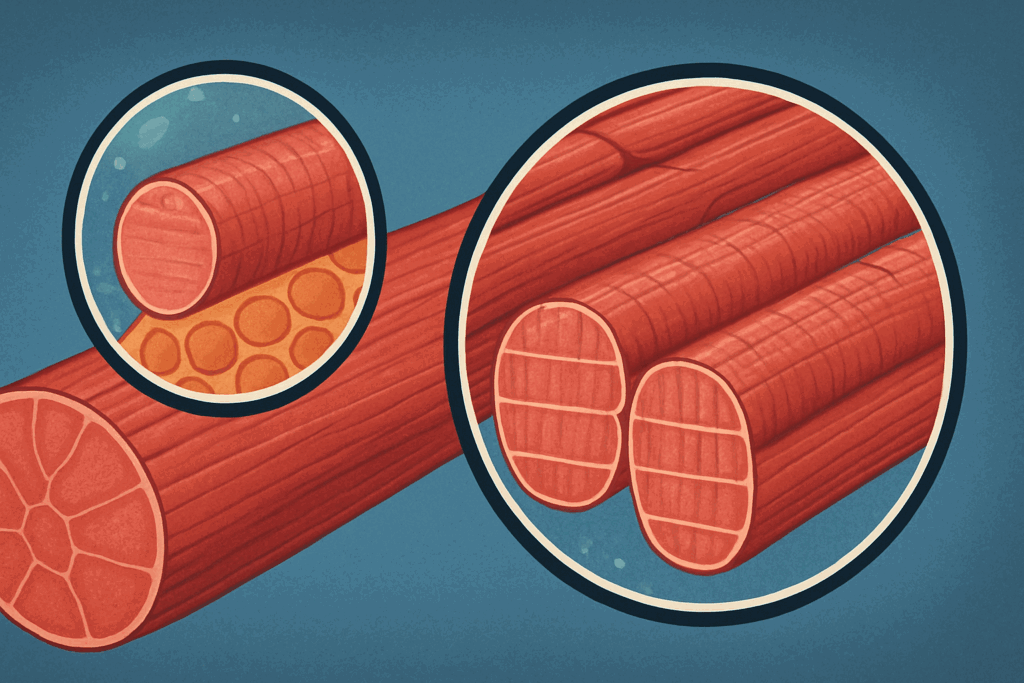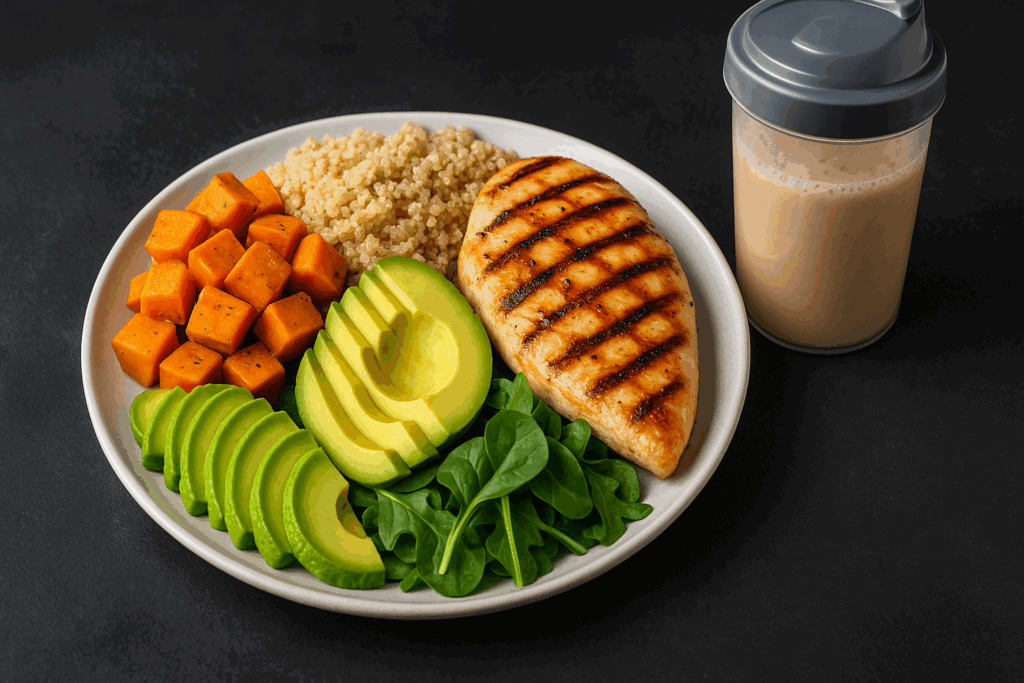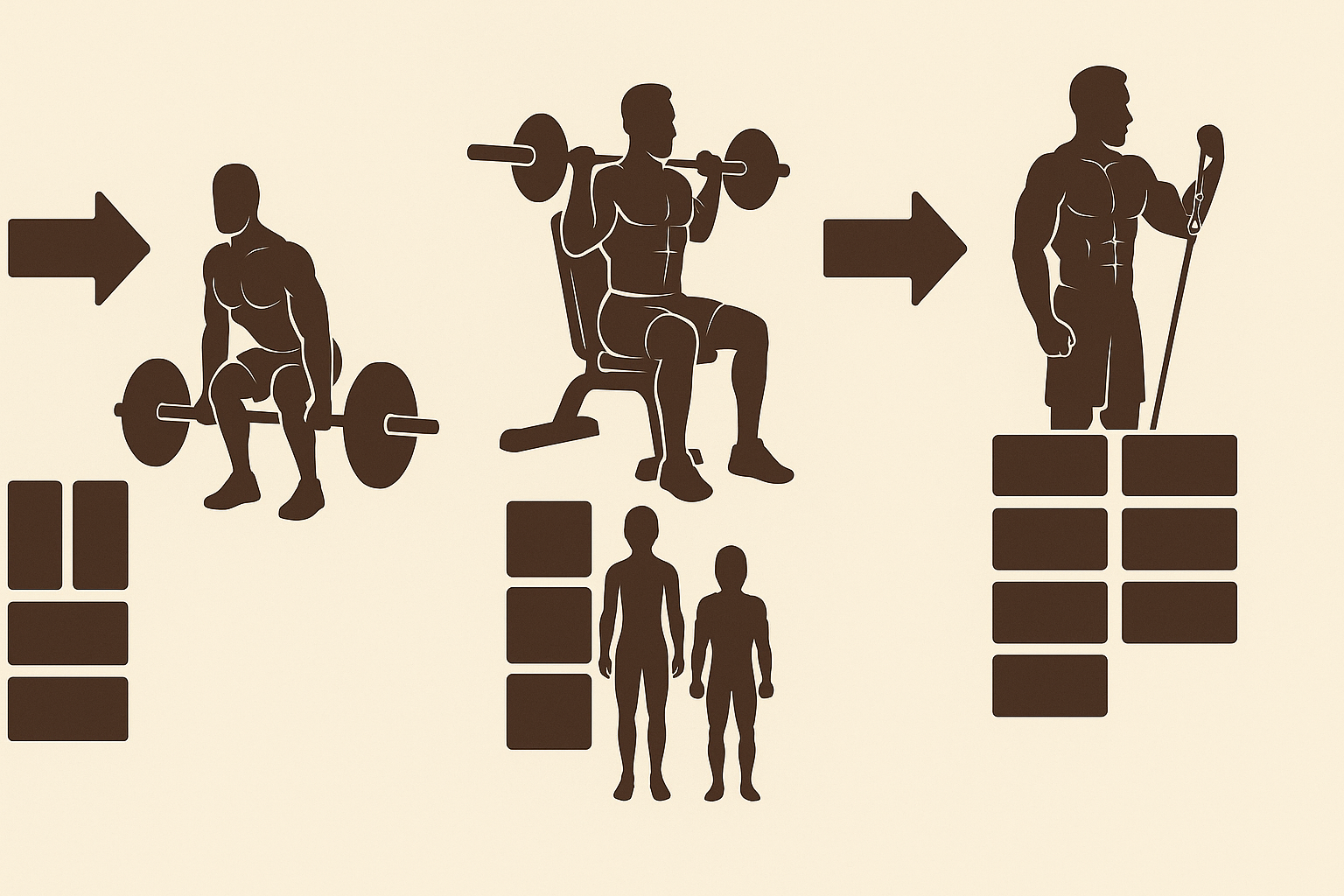Building muscle is both a science and an art, requiring precision, consistency, and an understanding of how the body responds to resistance training over time. For those seeking to maximize hypertrophy and build a stronger, more muscular physique, a well-structured training program is essential. The 8 week hypertrophy program is designed to deliver proven muscle-building results by aligning training volume, intensity, frequency, and recovery in a manner supported by both clinical evidence and practical application. Unlike generic plans, this program is tailored to maximize muscular development through progressive overload, metabolic stress, and mechanical tension—the three pillars of hypertrophic adaptation.
You may also like: The Ultimate Hypertrophy Workout Program for Building Strength and Size

Understanding the Science of Hypertrophy
Hypertrophy refers to the increase in muscle cell size, typically as a result of resistance training. While there are two primary types of muscular hypertrophy—sarcoplasmic and myofibrillar—most well-designed programs will target a blend of both to improve muscle volume and strength. Sarcoplasmic hypertrophy increases the volume of sarcoplasmic fluid in the muscle cell, contributing to a fuller appearance. Myofibrillar hypertrophy, on the other hand, involves an increase in the number and size of myofibrils, the contractile parts of the muscle, leading to greater force output.
To stimulate hypertrophy effectively, resistance training must challenge the muscles with sufficient load, time under tension, and recovery periods that allow adaptation. This is where the concept of periodization becomes crucial. Periodization refers to the systematic planning of training variables over time to optimize performance and recovery. In the context of an 8 week hypertrophy program, periodization allows for controlled progression that steadily increases demands on the musculature while minimizing the risk of overtraining.

Structuring Your 8 Week Hypertrophy Program for Maximum Impact
A hypertrophy training program typically revolves around manipulating training volume and intensity across weekly cycles. For optimal muscle growth, studies suggest training each major muscle group two to three times per week, incorporating a combination of compound and isolation exercises. The first few weeks of the program should prioritize establishing a foundational volume and intensity level, gradually increasing over time.
During the initial phase of the 8 week hypertrophy program, the goal is to prime the neuromuscular system with moderate weights and higher repetitions (8-12 reps per set). This helps develop muscular endurance and prepares the connective tissues for the heavier loads to come. Exercises such as squats, bench presses, deadlifts, and pull-ups serve as the foundation, while movements like biceps curls, triceps extensions, and lateral raises provide targeted stimulus.
In weeks three to five, training intensity increases with slightly heavier weights and lower rep ranges (6-10 reps), aiming to induce myofibrillar hypertrophy. During this period, it becomes essential to track progress meticulously, ensuring that each session either increases the load, volume, or quality of movement. Rest intervals between sets may shorten slightly to induce metabolic stress while maintaining high performance.
The final phase of the program (weeks six through eight) introduces advanced techniques such as drop sets, supersets, and rest-pause sets to amplify training density. These methods boost muscle damage and metabolic fatigue, two key drivers of hypertrophy. By this point, the body is primed for adaptation, and the accumulated volume of previous weeks sets the stage for significant gains in muscle mass.

The Critical Role of Nutrition in the 8 Week Hypertrophy Program
Training provides the stimulus for muscle growth, but nutrition supplies the raw materials. To support hypertrophy, individuals must consume a caloric surplus with an emphasis on high-quality protein intake. Amino acids—particularly leucine—activate muscle protein synthesis, the process by which the body builds new muscle tissue. A daily intake of 1.6 to 2.2 grams of protein per kilogram of body weight is recommended, distributed evenly across meals.
Carbohydrates play a vital role by replenishing glycogen stores and providing energy for intense workouts. Complex carbohydrates such as oats, brown rice, sweet potatoes, and whole grains should form the backbone of the diet, with simple carbs reserved for pre- and post-workout nutrition. Fats, while often overlooked, are essential for hormonal health, especially testosterone production, which is closely tied to muscle growth. Healthy sources include avocados, nuts, seeds, and fatty fish.
Timing also matters. Consuming protein and carbohydrates within an hour post-workout can accelerate recovery and enhance muscle protein synthesis. Hydration is another often underestimated factor; even mild dehydration can impair performance and recovery. A daily fluid intake of at least three liters is advisable, adjusted based on training intensity and environmental conditions.

Rest and Recovery: The Unsung Heroes of Hypertrophy
While the gym is where muscles are broken down, it is during rest that they are rebuilt. Recovery is a non-negotiable aspect of any effective hypertrophy program. Without adequate sleep, nutrition, and rest days, the body cannot repair and grow muscle tissue efficiently. Sleep, in particular, is critical, with research suggesting that seven to nine hours per night is optimal for individuals engaged in intense training.
Rest days should not be viewed as setbacks but as strategic opportunities for the body to adapt. Active recovery activities such as walking, stretching, or yoga can promote blood flow and reduce muscle soreness without interfering with recovery. In the context of the 8 week hypertrophy program, rest days are carefully positioned to allow for peak performance during training sessions while minimizing the risk of overtraining and injury.
Deload weeks, typically implemented in the middle or at the end of a hypertrophy cycle, involve reducing training volume and intensity to allow full systemic recovery. This not only rejuvenates the body but also prevents plateaus, as the body comes back stronger and more responsive to subsequent training stimuli.

8 Week Hypertrophy Program PDF: Designing a Practical, Evidence-Based Guide
Creating an accessible and effective training guide is essential for adherence and results. The 8 week hypertrophy program PDF serves as a detailed blueprint, outlining exercise selection, sets, reps, rest periods, and progression strategies. Each week is structured with specific goals, ensuring that trainees know exactly what to expect and how to execute the plan.
For example, Week 1 might include full-body workouts to establish a baseline, incorporating three sessions per week. As the program progresses, training splits evolve—transitioning to upper/lower body days or push/pull/legs routines. This ensures varied stimulus and sufficient recovery. The PDF also includes tracking sheets, mobility routines, and tips for exercise execution, making it a comprehensive resource for both beginners and intermediate lifters.
The inclusion of periodized training blocks, progressive overload parameters, and optional advanced techniques makes the hypertrophy workout plan PDF suitable for a wide audience. Trainees can adjust based on their experience, equipment availability, and time commitment. Providing a digital format allows for convenient access on smartphones or tablets, encouraging consistency and accountability.

Avoiding Common Pitfalls in Hypertrophy Training
Many individuals embark on muscle-building journeys with enthusiasm but fail to see significant progress due to avoidable mistakes. One of the most common errors is program hopping—switching training plans too frequently before adaptations occur. The body needs time to respond to a consistent stimulus, which is why adhering to an 8 week hypertrophy program is crucial for measurable results.
Another common issue is neglecting progressive overload. Simply repeating the same weights and reps each week will not elicit further muscle growth. It is essential to incrementally increase training variables—whether by lifting heavier, increasing repetitions, reducing rest periods, or improving movement quality. Without progression, the training stimulus becomes stagnant, leading to plateaus.
Overtraining is also a significant concern. While intensity is vital, more is not always better. Training too frequently without sufficient rest can lead to central nervous system fatigue, hormonal imbalances, and increased injury risk. Symptoms such as persistent soreness, insomnia, and decreased performance should be taken seriously and addressed promptly. Monitoring recovery markers and implementing deload weeks can help mitigate these risks.

The Psychology of Muscle Building: Staying Motivated Throughout the Program
Muscle-building is as much a mental challenge as it is a physical one. The initial excitement can wane as the weeks progress, especially when progress slows or external stressors interfere. Developing a resilient mindset is therefore essential. Setting clear, measurable goals at the start of the 8 week hypertrophy program provides direction and motivation.
Visual progress tracking, such as progress photos or strength logs, can reinforce the connection between effort and results. Celebrating small victories, such as a new personal best or visible muscle change, fuels momentum. Equally important is cultivating a growth mindset—recognizing that setbacks are part of the journey and that each challenge is an opportunity for improvement.
Social support can also play a pivotal role. Training partners, online communities, or fitness coaches provide accountability and encouragement. Sharing progress and experiences fosters a sense of community and shared purpose. Maintaining psychological well-being through stress management techniques, such as meditation or journaling, enhances focus and consistency, especially during challenging phases of the program.
Integrating the Hypertrophy Workout Plan PDF Into a Long-Term Strategy
The 8 week hypertrophy program is not an endpoint but a stepping stone toward long-term muscular development. Once completed, individuals can transition into other training phases, such as strength-focused blocks or maintenance periods, before returning to another hypertrophy cycle. This cyclical approach prevents burnout, sustains motivation, and optimizes physiological adaptation.
The hypertrophy workout plan PDF includes recommendations for post-program transitions, such as tapering training volume while increasing load to prioritize neural adaptations. This not only preserves muscle gains but also builds a stronger foundation for future hypertrophy. The document also encourages the evaluation of individual responses—what worked, what didn’t, and what can be improved in future cycles.
Tracking variables such as body composition, strength gains, recovery quality, and subjective well-being allows for data-driven decisions moving forward. These insights enable the creation of personalized hypertrophy programs that align with specific goals, whether they be aesthetics, performance, or functional strength. As trainees become more experienced, they may also explore more nuanced training variables, such as tempo manipulation or blood flow restriction training, to further enhance results.
Frequently Asked Questions About Maximizing Results with the 8 Week Hypertrophy Program
1.How does individual genetics influence outcomes from an 8 week hypertrophy program?
While the structure and consistency of a hypertrophy regimen are essential, individual genetic factors play a subtle yet meaningful role in determining the rate and extent of muscular development. For example, some individuals possess a higher concentration of type II muscle fibers, which respond more favorably to resistance training geared toward hypertrophy. Others may have a genetic predisposition for enhanced recovery capacity, allowing them to train at higher frequencies without compromising performance. Moreover, hormone levels—particularly testosterone, growth hormone, and IGF-1—can influence the speed at which muscle tissue is built and repaired. However, it’s important to recognize that while genetics set the ceiling for potential, the 8 week hypertrophy program is designed to push each individual toward their unique peak, regardless of their starting point.
2.What should I do if I plateau midway through the 8 week hypertrophy program?
Hitting a plateau during a hypertrophy phase is not uncommon and can be addressed through several practical adjustments. First, examine whether progressive overload has stalled—this could mean weight, reps, or training density hasn’t increased. If so, incorporating intensity techniques such as tempo manipulation, paused reps, or partial reps can reignite muscle adaptation. Additionally, adjusting nutrition may be key; increasing caloric intake slightly or shifting macronutrient ratios can support continued growth. A short deload or active recovery week may also help by allowing your central nervous system and connective tissues to regenerate, setting the stage for renewed progress. Lastly, ensure that sleep quality and stress management are optimized, as these factors can significantly affect recovery and growth potential within the structure of the 8 week hypertrophy program.
3.What advanced strategies can be integrated into the final phase of the hypertrophy workout plan PDF?
The latter stages of a hypertrophy program are ideal for incorporating more sophisticated strategies that create metabolic stress and mechanical tension. Techniques such as drop sets, where weights are reduced mid-set to allow continued reps, can amplify muscle fatigue and time under tension. Rest-pause training, in which short intra-set breaks allow for extended effort beyond typical failure points, is another powerful method. Cluster sets—where several mini-sets are completed within a single set block—can target both myofibrillar and sarcoplasmic hypertrophy simultaneously. These approaches challenge the musculature in new ways, promoting growth even in well-trained athletes. When used judiciously, they not only optimize results but also keep the hypertrophy workout plan PDF engaging and dynamic.
4.Can women follow the 8 week hypertrophy program with similar results?
Absolutely. Despite common misconceptions, women benefit from resistance-based hypertrophy training just as significantly as men, although results may manifest differently due to hormonal variations. The 8 week hypertrophy program enhances lean muscle development, metabolic rate, and strength in women, contributing to improved body composition and performance. While women have lower baseline testosterone levels, they typically experience enhanced muscular endurance and recovery, making them well-suited for volume-based hypertrophy training. Adjustments can be made to exercise selection and volume based on individual goals, such as emphasizing glute, hamstring, or shoulder development. Additionally, the inclusive structure of the hypertrophy workout plan PDF provides scalable programming that aligns well with the needs and physiology of female lifters.
5.How does the 8 week hypertrophy program accommodate joint health and injury prevention?
Joint health is a critical consideration, especially in programs that emphasize progressive overload. This 8 week hypertrophy program encourages proper warm-up protocols, mobility drills, and the inclusion of unilateral exercises to correct muscular imbalances. Emphasizing movement quality over load—particularly in exercises like squats, deadlifts, and pressing motions—can reduce cumulative joint stress while still promoting hypertrophy. The training structure also allows for adequate rest between sessions targeting similar joints or movement patterns, which is key to preventing repetitive strain injuries. Moreover, incorporating tempo-controlled eccentric phases helps to build tendon resilience, which supports long-term joint integrity and function. A well-designed program like this one recognizes that sustainable gains come from protecting, not punishing, the body.
6.What makes the 8 week hypertrophy program PDF more effective than generic training plans?
Unlike one-size-fits-all templates, the 8 week hypertrophy program PDF is designed with periodized progression, built-in recovery strategies, and adaptability based on user experience and goals. Its phased structure ensures that volume and intensity are systematically adjusted to stimulate consistent growth without causing burnout. In contrast, generic programs often neglect load management and do not offer sufficient guidance for tailoring based on individual capacity. The PDF version also includes features like tracking tools, form cues, and weekly benchmarks, making it both educational and actionable. Whether accessed by a novice lifter or an experienced gym-goer, the hypertrophy workout plan PDF fosters a deeper understanding of training principles while supporting execution with practical resources.
7.How can the 8 week hypertrophy program PDF be adapted for limited-equipment home training?
Although originally structured with access to a full gym in mind, the 8 week hypertrophy program PDF can be effectively adapted for home use with minimal equipment. Resistance bands, adjustable dumbbells, and a sturdy bench can replace most barbell-based movements with only minor compromises. Compound movements like goblet squats, single-leg deadlifts, and floor presses can replace their traditional counterparts. Time under tension becomes even more critical in low-load environments, so increasing tempo or volume per set can provide sufficient stimulus. The hypertrophy workout plan PDF includes optional exercise variations and rest-pause techniques that work well in minimalist settings, ensuring that users can maintain progression regardless of equipment access.
8.What psychological strategies can help maintain motivation throughout the 8 week hypertrophy program?
Long-term motivation requires more than discipline; it thrives on goal clarity, positive reinforcement, and psychological flexibility. Setting both performance-based and visual goals—such as improving your overhead press or tracking physique changes with photos—can create multiple layers of satisfaction. Incorporating habit-stacking, where workouts are paired with enjoyable routines like music or post-workout rituals, builds a sense of reward around training. Mental resilience is bolstered through self-reflection and journaling, which allow trainees to celebrate incremental wins and adjust mindsets during challenging periods. Moreover, engaging with online communities or support groups that follow the same 8 week hypertrophy program offers external accountability and encouragement. This social element adds enjoyment and shared purpose, helping participants maintain consistency and enthusiasm over time.
9.How should the hypertrophy workout plan PDF be modified for older adults or those returning from injury?
Older trainees or individuals coming back from injury should approach the hypertrophy workout plan PDF with a strategic emphasis on joint health, mobility, and progressive loading. Starting with reduced intensity and volume allows for neuromuscular reactivation and connective tissue adaptation. Exercises may need to be replaced or modified to accommodate limited range of motion or post-rehabilitative constraints—using machines or resistance bands, for example, can be more joint-friendly than free weights in some cases. The inclusion of warm-up sets, longer rest periods, and a focus on tempo control can greatly enhance safety and efficacy. While the 8 week hypertrophy program is robust, its design allows for flexible entry points, ensuring that a wide range of individuals can benefit while progressing at a sustainable pace.
10.Can the 8 week hypertrophy program serve as a foundation for long-term physique transformation?
Yes, the program is strategically designed to not only deliver immediate results but also to serve as a template for sustainable long-term transformation. Once the initial cycle is completed, users can transition into strength-focused blocks, cutting phases, or a second hypertrophy cycle with modified variables. The hypertrophy workout plan PDF includes guidelines for post-program evaluation, helping users identify what worked best and what could be improved. Over time, repeating the cycle with progressive changes to rep schemes, exercise selection, or rest intervals can continue driving adaptations without stagnation. As a result, the 8 week hypertrophy program becomes more than a short-term tool—it evolves into a personalized system for continual improvement in muscle growth, strength, and overall fitness.
Conclusion: Maximizing Results with the 8 Week Hypertrophy Program
Achieving meaningful muscle growth requires more than lifting weights; it demands strategic planning, nutritional discipline, and psychological resilience. The 8 week hypertrophy program offers a comprehensive, scientifically grounded framework that guides individuals through every phase of their muscle-building journey. By integrating periodized training, precise nutrition, strategic recovery, and consistent progression, this program empowers users to unlock their full muscular potential.
Whether accessed through the 8 week hypertrophy program PDF or implemented with the support of a hypertrophy workout plan PDF, the key to success lies in adherence, adaptability, and intentionality. The journey is not without its challenges, but the rewards—enhanced strength, confidence, and health—are well worth the effort. In embracing this proven blueprint, individuals are not merely following a plan; they are investing in a stronger, more capable version of themselves.
Further Reading:
8 Week Hypertrophy Training Program
Mike Israetel 5 Week Hypertrophy Workout Routine Spreadsheet





